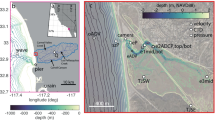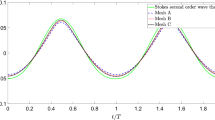Abstract
On many occasions, the effects of wind-induced waves and currents on flow and salinity fields in water bodies are evaluated separately. Some coupling mechanisms of the two phenomena, however, can have a significant impact on the flow and salinity conditions, in particular in sensitive aquatic ecosystems. This article attempts to quantify the wave contributions to the flow and salinity regimes in Lake Urmia, Iran. The salinity conditions in the lake have become an environmentally important subject, partly because this shallow hypersaline aquatic ecosystem is considered to be one of the largest natural habitats of a unique multicellular organism, Artemia urmiana. This brine shrimp is the major food source for many of the protected and rare shorebirds that visit the lake and can grow and survive in only certain ranges of salinity. The lake has also experienced considerable man-made changes during the past three decades. Previous studies that have modeled the flow and salinity regimes in the lake have overlooked the wave-coupling effects, and some have concluded that major remedial actions are necessary to restore the lake ecosystem. The wave-coupling effects were found to have significant impacts on the spatiotemporal variations of flow and salinity in the lake. Wave actions were intensifying vertical stratification, considerably influencing the flow and salinity regimes. It was found that improvements in the lake salinity conditions provided by the wave actions were comparable to potential improvements that expensive mitigation scenarios may offer. The relative magnitude of the wave coupling was found to be the highest in shallow/large water bodies, and it increased as the wave height and the initial salinity increased, suggesting that these wave-coupling effects are substantial, especially in large, shallow, hypersaline lakes.














Similar content being viewed by others
References
Abatzopoulos TJ, Baxevanis AD, Triantaphyllidis CD, Criel GVG, Pador EL, Van Stappen G, Sorgeloos P (2006) Quality evaluation of Artemia urmiana Günther (Lake Urmia, Iran) with special emphasis on its particular cyst characteristics (International Study on Artemia LXIX). Aquaculture 254:442–454
Ab-Niroo Consulting Company (1995) Hydraulic report (primary investigations of Shahid Kalantari highway in Lake Urmia), vol 5. Ab-Niroo Consulting Company, Company Report, Tehran (in Persian)
Alikhani M (1997) A model for variation of the water level and salinity in Lake Urmia (M.Sc. thesis). Amirkabir University, Tehran (In Persian)
Bakhtiari A (2009) Impact of the flow/wave interaction on the location/length of the causeway bridge in Lake Urmia (M.Sc. thesis). K.N. Toosi University of Technology, Tehran (in Persian)
Bakhtiaria A, Zeinoddini M (2011) Wave-current coupling effects on flow and salinity circulations and stratification in saline basins. Proc Environ Sci 10:1293–1301
Balas L, Özhan E (2002) Three-dimensional modelling of stratified coastal waters. Estuarine Coastal Shelf Sci 54:75–87
Blumberg AF, Mellor GL (1987) A description of a three-dimensional coastal ocean circulation model. In: Heaps NS (ed) Three-dimensional coastal ocean models. Am Geophys Union, Washington, DC, pp 1–16
Daneshvar N, Ashasi Sarkhabi H (1994) Investigation of the physical and chemical properties of water in the Lake Urmia. Environ J 17:32–43 (in Persian)
Davies AM, Lawrence J (1995) Modelling the effect of wave–current interaction on the three dimensional wind-driven circulation of the Eastern Irish Sea. J Phys Oceanogr 25:29–45
DHI Water and Environment (2007a) User guide for MIKE 3 (estuarine and coastal hydraulics and oceanography, hydrodynamic module). Scientific documentation. DHI Water and Environment, Hørsholm
DHI Water and Environment (2007b) User guide for MIKE 21 (estuarine and coastal hydraulics and oceanography, hydrodynamic module). Scientific documentation. DHI Water and Environment, Hørsholm
Djamali M, Kürschner H, Akhani H, de Beaulieu JL, Amini A, Andrieu-Ponel V, Ponel P, Stevens L (2008) Palaeoecological significance of the spores of the liverwort Riella (Riellaceae) in a late Pleistocene long pollen record from the hypersaline Lake Urmia, NW Iran. Rev Palaeobot Palynol 152:66–73
Eimanifar A, Mohebbi F (2007) Urmia Lake (Northwest Iran): a brief review. Saline Systems 3:5
Falah AA (2004) Definition of of wave induced wave and current in Lake Urmia (M.Sc. thesis). Tarbiat Modares University, Tehran (in Persian)
Fennel W, Lass HU (2007) On the impact of wind curls on coastal currents. J Mar Syst 68:128–142
Günther RT (1980) Contributions to the natural history of Lake Urmia, N.W. Persia and its neighborhood. J Linn Soc 27:394–398
Hang NTM, Don NC, Araki H, Yamanishi H, Koga K (2009) Applications of a new ecosystem model to study the dynamics of phytoplankton and nutrients in the Ariake Sea, west coast of Kyushu. Japan. J Marine Syst 75(1–2):1–16
Hoffmann KA, Chiang TC (1990) Computational fluid dynamics for engineers, vol 2. Engineering Education Systems, Wichita
Karbassi A, Nabi Bidhendi G, Pejman A, Esmaeili Bidhendi M (2010) Environmental impacts of desalination on the ecology of Lake Urmia. J Great Lakes Res 36:419–424
Komen GJ, Cavaleri L, Donelan M, Hasselmann K, Hasselmann S, Janssen PAEM (1994) Dynamics and modelling of ocean waves, Cambridge University Press, New York, p 532
Lesser GR, Roelvink JA, van Kester JATM, Stelling GS (2004) Development and validation of a three-dimensional morphological model. Coast Eng 51:883–915
Liang BC, Li HJ, Lee DY (2008) Sediment transport in coastal zones, effects from the wave–current interactions. J Hydrodynam Ser B 20(1):88–95
Liu H, Xie L (2009) A numerical study on the effects of wave–current–surge interactions on the height and propagation of sea surface waves in Charleston Harbor during Hurricane Hugo 1989. Continental Shelf Res 29(11–15):1454–1463
Liu WC, Chen WB, Kuo JT (2008) Modeling residence time response to freshwater discharge in a mesotidal estuary, Taiwan. J Marine Syst 74(1–2):295–314
Lopes JF, Dias JM (2007) Residual circulation and sediment distribution in the Ria de Aveiro lagoon, Portugal. J Marine Syst 68(3–4):507–528
Makhdoom M (2002) An overview on Urmia Lake and its basin researches. In: Proceeding of the conference on "Urmia Lake Causeway-Environmental Aspects”, Urmia, Iran, 10 to 11 December 2002. University of Tehran, Tehran (in Persian)
Marjani AA (2007) 3D modelling of salt balance and salt water exchange in Lake Urmia (M.Sc. thesis). Sharif University of Technology, Tehran
Marjani AA, Jamali A (2008) Water quality model of a hypersaline lake. In: Proc 5th Int Eng Construct Conf (IECC’5), Irvine, CA, USA, 27–29 August 2008
Mastenbroek C, Burgers G, Janssen PAEM (1993) The dynamical coupling of a wave model and a storm surge model through the atmospheric boundary layer. J Phys Oceanogr 23:1856–1866
Modaresi V (2002) Considering the hydrodynamic behaviour of the Lake Urmia related to the Shahid Kalantari Highway. Water Sewerage J 38:65–72 (in Persian)
Montaseri H (2002) Geographical Information Systems (GIS) application in hydrodynamic of coastal regions (M.Sc. thesis). Tarbiat Modares University, Tehran (in Persian)
Moon IJ (2005) Impact of a coupled ocean wave–tide–circulation system on coastal modelling. Ocean Model 8:203–236
Ozkan-Haller HT, Li Y (2003) Effects of wave–current interaction on shear instabilities of longshore currents. J Geophys Res 108:3139
Perrie W, Tang CL, Hu Y, DeTracy BM (2003) The impact of waves on surface currents. J Phys Oceanogr 33:2126–2140
Reniers AJHM, Roelvink JA, Thornton EB (2004) Morphodynamic modelling of an embayed beach under wave group forcing. J Geophys Res 109:C01030
Sadra Company (2004) Hydrodynamic and hydraulic and environmental investigation report (design and construction of the Oromieh Lake causeway), rev. 4. Sadra Company, Tehran
Shafieefar M (2005) Salinity circulation in the Urmia Lake after construction of the causeway. In: Proc 31st IAHR Congr, Soeul, Korea, 11–16 Sept 2005
Sorensen RM (1997) Basic coastal engineering. Springer, Berlin
Talebizadeh M, Moridnejad A (2010) Uncertainty analysis for the forecast of lake level fluctuations using ensembles of ANN and ANFIS models. Expert Syst Appl. doi:10.1016/j.eswa.09.075
Tarh-e-Noandishan Consulting Company (2004) Broad investigations of hydraulic in Lake Urmia. Tarh-e-Noandishan Consulting Company, Company Report, Tehran (in Persian)
Terrile E, Brocchini M, Christensen KH, Kirby JT (2008) Dispersive effects on wave-current interaction and vorticity transport in nearshore flow. Phys Fluid 20:036602
Tofighi MA, Zeinoddini M, Golshani AA (2006) Two dimensional simulation of Urmia Lake hydrodynamics for predicting the flow regimes. Iran J Marine Eng 3(4):37–47 (in Persian)
Tofighi MA, Zeinoddini M, Golshani AA (2009) Investigation into the flow stratification in the Urmia Lake using a 3D hydrodynamics flow model. Modarres Tech Eng Sci Res J 35:65–76 (in Persian)
Uchiyama Y, McWilliams JC, Restrepo JM (2009) Wave–current interaction in nearshore shear instability analyzed with a vortex force formalism. J Geophys Res 114:C06021
Uchiyama Y, McWilliams JC, Shchepetkin AF (2010) Wave-current interaction in an oceanic circulation model with a vortex-force formalism: application to the surf zone. Ocean Modell 34:16–35
UNESCO (1981) The Particle Salinity Scale 1978 and International Equation of State of Seawater 1980 (UNESCO technical papers in marine science, vol 36). UNESCO, Paris
USACE (2006) Coastal hydrodynamics (Chap II, Pt 2; chairman: Zeki Demirbilek). In: Coastal engineering manual (CEM). Coastal Engineering Research Center, US Department of Army Corps of Engineers (USACE), Washington, DC (updated: June 2006)
Warner JC, Sherwood CR, Signell RP, Harris CK, Arango HG (2008) Development of a three-dimensional, regional, coupled wave, current, and sediment transport model. Comput Geosci 34:1284–1306
Wurtsbaugh WA, Gliwicz ZM (2001) Limnological control of brine shrimp population dynamics and cyst production in the Great Salt Lake, Utah. Hydrobiologia 466:119–132
Xia H, Xia Z, Zhu L (2004) Vertical variation in radiation stress and wave-induced current. Coast Engg 51:309–321
Xie L, Wu K, Pietrafesa LJ, Zhang C (2001) A numerical study of wave–current interaction through surface and bottom stresses: wind-driven circulation in the South Atlantic Bight under uniform winds. J Geophys Res 106:16841–16855
Xie L, Pietrafesa LJ, Wu K (2003) A numerical study of wave–current interaction through surface and bottom stresses: coastal ocean response to Hurricane Fran of 1996. J Geophys Res 108(C2):3049. doi:10.1029/2001JC001078
Young IR (1999) Wind generated ocean waves (Ocean Engineering Book Series, vol 2). Elsevier, Amsterdam
Yu J, Slinn DN (2003) Effect of wave–current interaction on rip currents. J Geophys Res 108:3088
Zeinoddini M, Tofighi MA, Vafaee F (2009) Evaluation of a dike type causeway impacts on the flow and salinity regimes in the Urmia Lake. J Great Lakes Res 35(1):13–22
Acknowledgments
The authors wish to express their appreciation to the Water Research Institute (WRI) of Iran for their support and computing facilities.
Author information
Authors and Affiliations
Corresponding author
Additional information
Handling Editor: Tomoyasu Fujii.
Rights and permissions
About this article
Cite this article
Zeinoddini, M., Bakhtiari, A. & Ehteshami, M. Wave–flow coupling effects on spatiotemporal variations of flow and salinity in a large hypersaline marine system: Lake Urmia, Iran. Limnology 14, 77–95 (2013). https://doi.org/10.1007/s10201-012-0389-1
Received:
Accepted:
Published:
Issue Date:
DOI: https://doi.org/10.1007/s10201-012-0389-1




